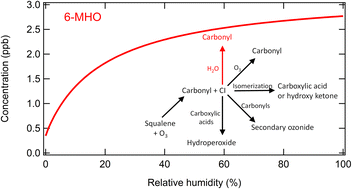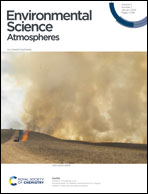Quantifying the impact of relative humidity on human exposure to gas phase squalene ozonolysis products†
Abstract
Squalene is a major skin oil lipid which can react with ozone forming a range of products including carbonyls, carboxylic acids, hydroxy ketones, secondary ozonides and hydroperoxides. Previous experimental studies have shown that the yield of these products depends on relative humidity. A new mechanism is developed which treats the reaction of ozone with carbon–carbon double bonds and the subsequent reactions of the Criegee intermediates forming a range of products in both condensed and gas phases. The mechanism is included in kinetic models for a variety of ozonolysis reaction systems including pure squalene particles, squalene and skin oil films, clothing, and skin covered by clothing. The models reproduce experimental measurements reasonably well using relatively consistent parameters, providing insights into the important reactions and processes controlling the concentrations of different species. In general, gas-phase secondary carbonyl product concentrations increase significantly as a function of relative humidity due to their formation from the reaction of Criegee intermediates with water, while carboxylic acids and hydroxy ketone concentrations decrease. For example, human exposure to gas-phase 6-methyl-5-hepten-2-one can increase by approximately a factor of two as the relative humidity increases from 10% to 95%. The model can also reproduce the decay of carboxylic acids in skin oil due to their reaction with Criegee intermediates. Discrepancies between some of the measurements and model outputs indicate that in addition to impacting chemistry, relative humidity may affect other processes such as partitioning to surfaces and condensed-phase diffusion.

- This article is part of the themed collection: Emerging Investigator Series


 Please wait while we load your content...
Please wait while we load your content...